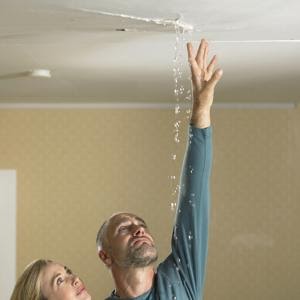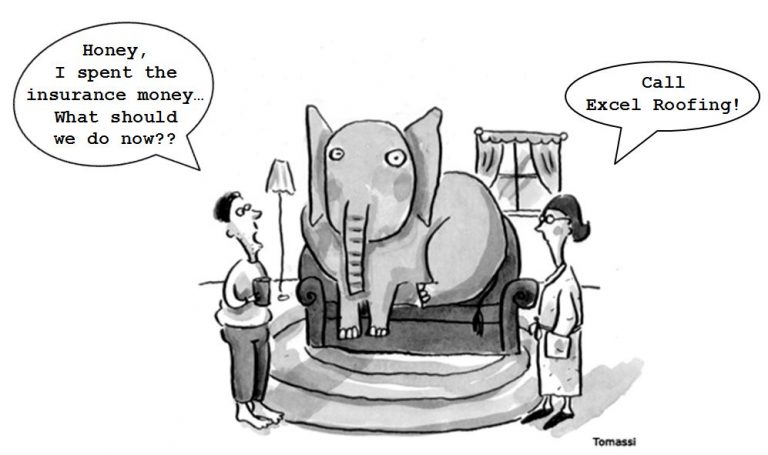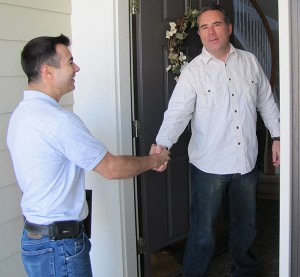Roof Leaks
The signs of a leaking roof are usually very noticeable. The most common indicators are spots and discoloration on ceilings and walls. Visible mold near moist spots on walls or ceilings is an indication of a moisture problem within an attic, usually as a result of improper ventilation or a leak. Curling, buckling, or missing shingles are also a warning sign of moisture penetrating the roofs surface. Damaged flashing near chimneys or vents can also be an early indicator of a moisture problem. Once you determine your roof is leaking, it is pertinent to get the leak fixed as quickly as possible to avoid any further damage. Here are five tips on how to find a leak in your roof.
How to Find a Leak in Your Roof
- First step is to check your gutters. Sometimes gutters get blocked and can back up. These blocks can act just like a roof leak so make sure the gutters are clear.
- Simply look up at the ceiling. Water spots are a surefire sign that you have some water reaching places it shouldn’t. The next place to inspect would be the attic. If water is leaking through the roof, the attic will show some signs of water leakage. Go up with a flashlight and check for dripping water. Look for signs of water staining on the underside of the roof boards. Also look for wet insulation.
- Inspect the roof above the stains. Look for any holes or other penetrations in the roof. Items that penetrate the roof are by far the most common source of leaks. For example, roofing nails that have started to leak will have dark spots around the nail. It is rare that a roof will develop a leak in open areas of uninterrupted shingles. Check areas around roof vents, plumbing, chimneys, skylights, dormers or anything else that is built through the roof.
- If the issue still isn’t obvious, recruit a helper to climb on the roof with a garden hose. In the attic, knock on the area where the leak appears to be so the helper knows where to start applying the water. Start soaking the area just above the leak and work up from there. Soak each area for a few minutes before moving on to a higher area. This will give the water ample time to work its way through the roof and spot the leak. Give a yell when the leak becomes visible. Remember to be patient—it takes time for the water to penetrate any leaks.
- If running water over the roof doesn’t reveal the location of the leak, it may be time to start pulling up shingles in the area of the leak. With the shingles out of the way, tracking the leak should be even easier. Discolored paper, water stains, or rotted wood will all be in the vicinity of the leak. Start looking up from the stains for any penetrations in the roof as this is likely the source of the leaking roof.
How to Avoid Future Roof Leaks
Hire professional roofing installers.
Hiring an experienced Denver roofer is a critical component to avoiding a damaged roof in the future. The roof is the most essential part of the structure of a house. A properly installed roof will aid in the safety of a home, and most importantly, the people that live in it. Even the tiniest of leaks can create colossal amounts of rotting wood and mold.
Invest in quality roofing materials.
There are several components to consider when choosing which materials to use for roof installation.
- Budget
- Climate and general weather patterns in your area
- Preferred style
- The architecture of your home
It’s important to keep in mind that although roofs play a critical part in securing the structure of a home, it also plays a pivotal role in the overall look of a home. Additionally, harsher winters or areas with a high rainfall average should heavily way on your decision of which roof material is best. Discuss these factors along with your budget with a professional to get the best roof for your home.
Maintain your roof.
A roof leak can occur when the roofing material has decayed during extreme circumstances, such as an ice dam, that pushes the original design beyond limitations. In these instances, the roof deck becomes exposed to moisture. Roof maintenance will help monitor the decay of your roof as well as eliminate extreme circumstances. The most important maintenance tasks to reduce and potentially avoid roof leaks are:
- Make sure ice dams are removed in the winter
- Clean your gutters in the spring and fall
- Have your chimney inspected annually
- Check regularly for signs of moisture around skylights and roof vents
Although you cannot completely avoid roof leaks, taking these steps will greatly improve your chances of eliminating any roof problems.
Call us at Excel Roofing and we’ll send an expert out to inspect your roof. We have been dealing with leaky roofs and other roofing issues for years and have the knowledge and experience to get the job done!










